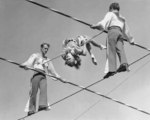 I apologize, because this is going to be a bit long, and it really should be about a play I performed in high school, and it isn’t.
I apologize, because this is going to be a bit long, and it really should be about a play I performed in high school, and it isn’t.
When someone asks me what I’m writing, now that I’ve had some time (and years) to actually think about it, I call it magical realism (except that it isn’t magical realism by some literary grognard’s definition of the term — it doesn’t obey the ‘rules’ of the official definition, but more the mindset). I don’t think of it as a genre as much as mode of writing — creating a story with two conflicting perspectives, one based on a rational view of reality and the other on the supernatural. Neil Gaiman’s Anansi Boys – with Fat Charlie and Spider representing the two views – is a really easy example, but there are many others.
Writing that kind of story — trying to — has a ‘gotcha’ that causes me a fair bit of stress during rewrites. I’m not going to be able to sum this up in a very tidy package, but here goes:
There are two ways you can approach the Fantastic in a story, regardless of the setting: there’s the ‘magical’ way and the ‘fantasy’ way.
The fantasy way is the most common, I think; especially in any book series where you learn more and more about the world in which the story is set. Basically, there is magic or something supernatural in the world, and as we spend more time in that place, more and more of the ‘system’ behind the magic is explained, until we know all the rules. There are lots and lots of examples of this, but Tolkien started it, and it’s carried into any number of series. Laurel K. Hamilton is one. Tamora Pierce. Harry Potter, certainly. Charles de Lint, sadly. George R. R. Martin, happily. In short, it’s a world with special rules, but once those rules are understood, the world works in predictable ways; what I think of as the Arthur C. Clarke version of magic. (To my mind, this often takes the ‘fantastic’ out of the fantasy, but that’s my own problem with some writers, and only really a problem when they mean not to do it and do it anyway.)
The magical way doesn’t quite explain how things work. Fairy tales are like this. Things aren’t predictable, and the magic isn’t ever quite explained. Some things are the way they are because that’s how they are. You don’t question it; it just is. There is a kind of childlike acceptance of the unreal here; ‘superstitious peasant’ reasoning. Neil Gaiman does this very well, as does Holly Black some of the time.
That kind of magical thinking is what I strive for.
Please understand: I love a good fantasy. Nothing wrong with them at all… unless that isn’t what you wanted to write. Fantasy for the sake of fantasy is great fun. Fantasy masquerading as a magical tale is going to feel flat and technical and lifeless.
And that’s the danger of the magical mode. You must be very true and accurate to the reader. Stuff has to be clear (more importantly, it has to be true, but right after that, it has to be clear), but you can’t explain everything, or you ruin it.
What happens and why it happens has to crystalline and solid, but at the same time you have to abide by the rule of magical thinking which is that sometimes, things are the way they are just because, and if you show someone all the gears and connections, the magic goes away.
Said from the point of view of the writer.: If you reveal too much of the wrong stuff, it’s not magical anymore – it’s just a fantasy.
That’s the balancing act I’m performing — there are some things in the story that aren’t clear, and I don’t want to alienate or confuse the reader (at least not unintentionally), but I am loathe to explain too much, because I do not. want. to. write. a. fantasy.

